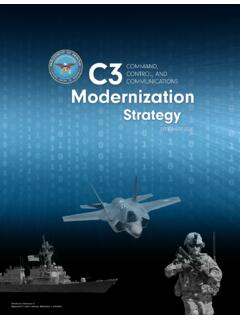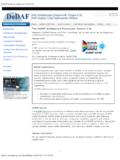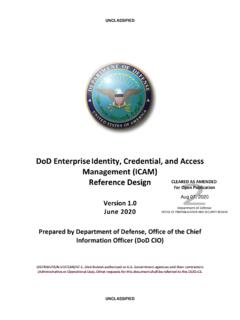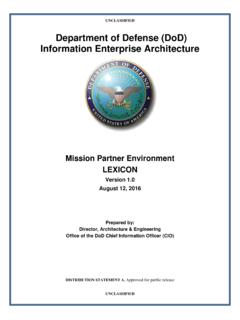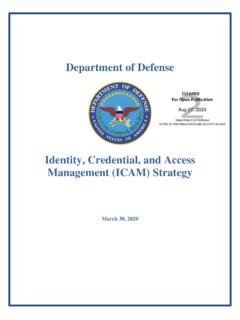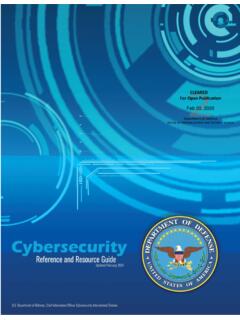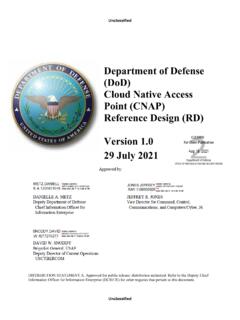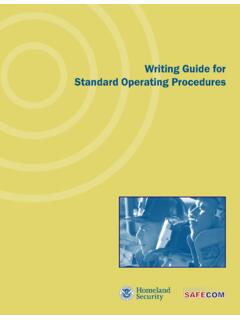Transcription of DOD Outside the Continental United States Cloud Strategy
1 UNCLASSIFIED Department of Defense Outside the Continental United States (OCONUS) Cloud Strategy April 2021 Office of the DoD Chief Information Officer Rev: 4/2 1/2021 UNCLASSIFIED Foreword "The reemergence of long-term strategic competition, rapid dispersion of technologies, and new concepts of warfare and competition that span the entire spectrum of conflict require a Joint Force structured to match this reality. To succeed in the emerging security environment, our Department and Joint Force will have to out-think, out-maneuver, out-partner, and out-innovate revisionist powers, rogue regimes, terrorists, and other threat actors. To support these missions, the Joint Force must gain and maintain information superiority .. " 2018 National Defense Strategy " Cloud devices employed by warfighters at the tactical edge .. will ensure warfighters are retaining data, feeding it back into models, and fighting with the most recent algorithms.
2 Doing this in a secure environment will be a force multiplier and directly support the primary goal of the Cloud environment: information superiority. " 2018 DoD Cloud Strategy The Department of Defense (DoD) Outside the Continental United States (OCONUS) Cloud Strategy establishes the vision and goals for enabling a dominant all-domain advantage through Cloud innovation at the tactical edge. It identifies areas requiring modernization to realize the potential of Cloud computing in direct support of the warfighter, specifically: security, redundancy, reliability, and availability. It focuses on extending Continental United States (CONUS) Cloud computing to the globally deployed elements of the Department to include the African, European, Indo-Pacific, Middle Eastern, and South American Theaters to the tactical edge. The outcomes of the Strategy align with and further the priorities of the National Defense Strategy and DoD Digital Modernization Strategy .
3 DoD is committed to providing Cloud computing to the warfighter at the tactical edge. These resources are fundamental to enabling a Joint Force capable of quickly and decisively mobilizing air, land, sea, space, and cyberspace capabilities in response to adversaries threatening United States ( ) and Allied National Security priorities and objectives. Acting, Chief Information Officer of the Department of Defense 11 UNCLASSIFIED Table of Contents Foreword .. ii 1. Operational Challenges at the tactical Edge .. 1 2. DoD OCONUS Cloud Vision .. 1 3. Goals and Objectives .. 2 3 .1. Goal # 1: Provide Robust and Resilient Connectivity to the tactical Edge .. 2 Objective 1: Modernize in Theater Communications Infrastructure .. 3 Objective 2: Secure Cloud Connections Through OCONUS Cloud Access Points .. 3 Objective 3: Leverage State-Of-The-Art Technologies to Connect D-DIL Environments .. 3 Objective 4: Enable Access to Information From Multiple Devices and Data Sources.
4 3 Goal #2: Provide Computing Power that Enables Forces at the tactical Edge .. 3 Objective 1: Deploy OCONUS Cloud Computing Under an Enterprise Construct.. 4 Objective 2: Optimize Data Center Infrastructure for Resilient Access to Data and Objective 3: Provide Ability to Traverse Cloud Environments for Persistent Data Access .. 4 Objective 4: Protect Data in the Cloud While Enabling Information Sharing .. 5 Goal #3: Deploy Talent at the Point ofNeed .. 5 Objective 1: Establish OCONUS Rotations for Technical Talent.. 5 Objective 2: Institute Training for OCONUS Users to Maximize Use of Cloud Resources .. 5 Objective 3: Deploy Research Talent to Better Address OCONUS Challenges .. 5 4. OCONUS Unique Considerations .. 6 Host Nations .. 6 Real Estate, Space, and Power .. 6 D-DIL Environments .. 6 Data Sovereignty in the Mission Partner Environment (MPE) .. 6 5. Next Steps .. 7 111 UNCLASSIFIED 1. Operational Challenges at the tactical Edge The OCONUS environment presents unique challenges in meeting warfighter and mission owner requirements based on geographic location, mission set, partnerships, and operating conditions.
5 Every warfighting asset, including the warfighters themselves, is a potential producer and/or consumer of information. This information must be accessed, analyzed, and distributed to enable data-driven decisions at the speed of relevance. Operating effectively in theater requires persistent access to data sources and producers within a transient, dynamic, and often contested environment. The most significant challenge OCONUS users face is access and sharing information in Denied, Disconnected, Intermittent, or Limited (D-DIL) environments. This challenge is further complicated by the reliance on reach-back to CONUS to access data repositories, analytical technologies, and artificial intelligence/machine learning (Al/ML) advancements for the production of more precise, impactful information and thereby, advancing more informed decision making. Hostile cyber actors will continue using technical and non-technical means to attempt to defeat the Cloud 's cybersecurity safeguards, access data and information, and interfere with or disable systems.
6 An adversary's capabilities will evolve over time to become more lethal and elusive. It is essential that every DoD Cloud employ world-class cybersecurity capabilities to continuously overmatch the threat. Valuable data collected and stored locally in theater to support mobile mission sets are often disconnected from broader CONUS-based data repositories, impeding the ability of geographically separated forces to process and correlate perishable information. The joint battlespace requires innovative approaches to Cloud resources to ensure data is available at the point of need. At the tactical edge, use of Cloud computing requires secure information sharing through human-to-human collaboration, human-to-machine teaming, and machine-to-machine data exchange while remaining, secure, redundant and available to the warfighter. 2. DoD OCONUS Cloud Vision Enable dominant all-domain advantage through Cloud innovation and resilience.
7 Cloud computing can help solve today's national defense challenges, but its true potential is to solve tomorrow's challenges. These challenges will require a Joint Force capable of quickly and decisively maneuvering and mobilizing air, land, sea, space, and cyber capabilities in response to adversaries threatening and Allied National Security priorities and objectives. Collaboration across these domains, increasingly enabled by high-tech, software-driven solutions, must occur at the global point of need, at the tactical edge, and at the fight. These collaborative efforts can't happen without a modem and resilient OCONUS infrastructure, of which Cloud computing and zero trust principles are fundamental. The DoD OCONUS Cloud Strategy establishes goals and objectives specifically focused on delivering Cloud innovation forward to the tactical edge with the intent of achieving the following outcomes: 1 UNCLASSIFIED An All-Domain Advantage: Modem warfare will require a force that can quickly utilize all appropriate assets in a decisive and concerted response.
8 As such, operational strategies and plans will leverage information from strategic-level commands; sensors across air, land, sea, and space; cyber threat and vulnerability sources; and logistics and resource systems. Additionally, executing these strategies and plans will require cutting-edge analytics of critical information to ensure conditions remain appropriate and opportunities still exist. Cloud computing must enable this data aggregation by providing compute and store capacity with the global reach and innovative services to realize data potential through a data-centric design. Information Advantage for the Wa,fighter: The combination of access to a greater breadth of data and the growing use of wearable digital components, Internet of military things (IoMT), and unmanned systems (UMS) enable warfighters to transform Cloud resources into an operational and tactical advantage. AI/ML must analyze and process large data files to inform the warfighter's decision.
9 This will require computing capacity and innovative services at the tactical edge. Through mobile data centers and edge computing technologies, Cloud computing must support these processing power requirements for our warfighters when and where needed. Continued Innovation of Capabilities: DoD's weapon systems and mission capabilities will be increasingly influenced by and dependent on software. Abilities such as rapidly implementing or tuning AI/ML algorithms, immediately responding to cyber threats, and deploying new software to fighter aircraft in flight will be critical. Accordingly, fighting and winning on the next battlefield will be dependent on the Department's proficiency in the rapid acquisition, integration, testing, and deployment of new software and Cloud computing capabilities. Cloud computing, applying continuous delivery of services models ( , Development, Security, and Operations (DevSecOps), Continuous Integration/Continuous Delivery or Continuous Integration/Continuous Deployment (CI/CD)), and Infrastructure as Code (IaC)) must enable continued innovation of digitally driven capabilities while in the fight.
10 3. Goals and Objectives Delivering Cloud innovation to the tactical edge requires modernization within all layers of the infrastructure. This modernization must meet the needs of a range of user-profiles in theater, from the warfighter operating Outside the wire to the mission planner or I. T. administrator operating within an established base perimeter or humanitarian efforts. The following goals are specific for OCONUS modernization, taking into account the range of user-profiles and integration with enterprise Cloud resources. Goal #I: Provide Robust and Resilient Connectivity to the tactical Edge Warfighters at the tactical edge must inform and be informed by strategic-level planning. The need to receive the most current information by leaders OCONUS or to provide the latest information to leaders in CONUS is crucial in operational planning efforts and in achieving a decision-making advantage. The warfighter often operates in environments with limited bandwidth, sporadic connectivity, or no connection to the Internet due to OCONUS infrastructure and/or physical limitations.
